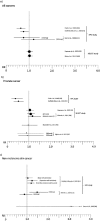Friend or foe? The current epidemiologic evidence on selenium and human cancer risk
- PMID: 24171437
- PMCID: PMC3827666
- DOI: 10.1080/10590501.2013.844757
Friend or foe? The current epidemiologic evidence on selenium and human cancer risk
Abstract
Scientific opinion on the relationship between selenium and the risk of cancer has undergone radical change over the years, with selenium first viewed as a possible carcinogen in the 1940s then as a possible cancer preventive agent in the 1960s-2000s. More recently, randomized controlled trials have found no effect on cancer risk but suggest possible low-dose dermatologic and endocrine toxicity, and animal studies indicate both carcinogenic and cancer-preventive effects. A growing body of evidence from human and laboratory studies indicates dramatically different biological effects of the various inorganic and organic chemical forms of selenium, which may explain apparent inconsistencies across studies. These chemical form-specific effects also have important implications for exposure and health risk assessment. Overall, available epidemiologic evidence suggests no cancer preventive effect of increased selenium intake in healthy individuals and possible increased risk of other diseases and disorders.
Figures



Similar articles
-
Risk of chronic low-dose selenium overexposure in humans: insights from epidemiology and biochemistry.Rev Environ Health. 2009 Jul-Sep;24(3):231-48. doi: 10.1515/reveh.2009.24.3.231. Rev Environ Health. 2009. PMID: 19891121 Review.
-
Overview of the epidemiology methods and applications: strengths and limitations of observational study designs.Crit Rev Food Sci Nutr. 2010;50 Suppl 1(s1):10-2. doi: 10.1080/10408398.2010.526838. Crit Rev Food Sci Nutr. 2010. PMID: 21132580 Free PMC article.
-
Selenium for preventing cancer.Cochrane Database Syst Rev. 2018 Jan 29;1(1):CD005195. doi: 10.1002/14651858.CD005195.pub4. Cochrane Database Syst Rev. 2018. PMID: 29376219 Free PMC article. Review.
-
The need for a reassessment of the safe upper limit of selenium in drinking water.Sci Total Environ. 2013 Jan 15;443:633-42. doi: 10.1016/j.scitotenv.2012.11.025. Epub 2012 Dec 7. Sci Total Environ. 2013. PMID: 23220755
-
Selenium neurotoxicity in humans: bridging laboratory and epidemiologic studies.Toxicol Lett. 2014 Oct 15;230(2):295-303. doi: 10.1016/j.toxlet.2013.11.016. Epub 2013 Nov 22. Toxicol Lett. 2014. PMID: 24269718 Review.
Cited by
-
Selenium exposure and the risk of type 2 diabetes: a systematic review and meta-analysis.Eur J Epidemiol. 2018 Sep;33(9):789-810. doi: 10.1007/s10654-018-0422-8. Epub 2018 Jul 5. Eur J Epidemiol. 2018. PMID: 29974401 Review.
-
Selenium: An Element of Life Essential for Thyroid Function.Molecules. 2021 Nov 23;26(23):7084. doi: 10.3390/molecules26237084. Molecules. 2021. PMID: 34885664 Free PMC article. Review.
-
Aspects of a Distinct Cytotoxicity of Selenium Salts and Organic Selenides in Living Cells with Possible Implications for Drug Design.Molecules. 2015 Jul 31;20(8):13894-912. doi: 10.3390/molecules200813894. Molecules. 2015. PMID: 26263963 Free PMC article.
-
Selenium Status Is Associated With Insulin Resistance Markers in Adults: Findings From the 2013 to 2018 National Health and Nutrition Examination Survey (NHANES).Front Nutr. 2021 Jun 28;8:696024. doi: 10.3389/fnut.2021.696024. eCollection 2021. Front Nutr. 2021. PMID: 34262926 Free PMC article.
-
Risk of leukemia in relation to exposure to ambient air toxics in pregnancy and early childhood.Int J Hyg Environ Health. 2014 Jul;217(6):662-8. doi: 10.1016/j.ijheh.2013.12.003. Epub 2013 Dec 25. Int J Hyg Environ Health. 2014. PMID: 24472648 Free PMC article.
References
-
- Brozmanova J, Manikova D, Vlckova V, Chovanec M. Selenium: a double-edged sword for defense and offence in cancer. Arch Toxicol. 2010;84:919–938. - PubMed
-
- Bodnar M, Konieczka P, Namiesnik J. The properties, functions, and use of selenium compounds in living organisms. J Environ Sci Health C Environ Carcinog Ecotoxicol Rev. 2012;30:225–252. - PubMed
-
- Vinceti M, Maraldi T, Bergomi M, Malagoli C. Risk of chronic low-dose selenium overexposure in humans: insights from epidemiology and biochemistry. Rev Environ Health. 2009;24:231–248. - PubMed
Publication types
MeSH terms
Substances
Grants and funding
LinkOut - more resources
Full Text Sources
Other Literature Sources
